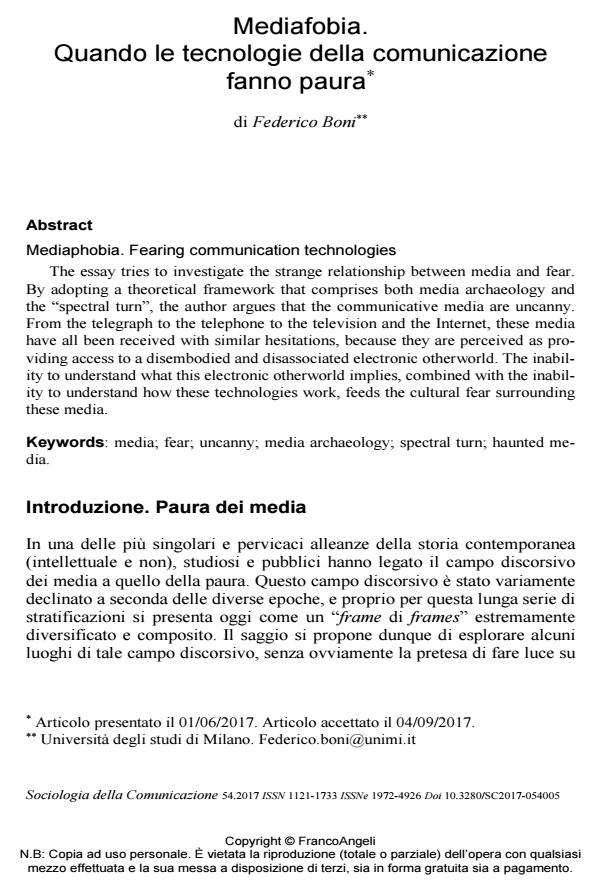Mediafobia. Quando le tecnologie della comunicazione fanno paura
Titolo Rivista SOCIOLOGIA DELLA COMUNICAZIONE
Autori/Curatori Federico Boni
Anno di pubblicazione 2018 Fascicolo 2017/54
Lingua Italiano Numero pagine 16 P. 64-79 Dimensione file 75 KB
DOI 10.3280/SC2017-054005
Il DOI è il codice a barre della proprietà intellettuale: per saperne di più
clicca qui
Qui sotto puoi vedere in anteprima la prima pagina di questo articolo.
Se questo articolo ti interessa, lo puoi acquistare (e scaricare in formato pdf) seguendo le facili indicazioni per acquistare il download credit. Acquista Download Credits per scaricare questo Articolo in formato PDF

FrancoAngeli è membro della Publishers International Linking Association, Inc (PILA)associazione indipendente e non profit per facilitare (attraverso i servizi tecnologici implementati da CrossRef.org) l’accesso degli studiosi ai contenuti digitali nelle pubblicazioni professionali e scientifiche
- Abruzzese A. (2003), Mostro, in id. (a cura di), Lessico della comunicazione, Meltemi, Roma, pp. 385-388.
- Alexander J.C. (2013), The Dark Side of Modernity, Sage, London-New York. Blanco M., Peeren E. (eds.) (2013), The Spectralities Reader. Ghosts and Haunting in Contemporary Cultural Theory, Bloomsbury, London-New York.
- Boluk S., Lenz W. (2011), Introduction: Generation Z, the Age of Apocalypse, in iid. (eds.), Generation Zombie. Essays on the Living Dead in Modern Culture, McFarland & Company, Jefferson (NC), pp. 1-17.
- Bottomore S. (1999), The Panicking Audience?: early cinema and the “train effect”, in «Historical Journal of Film, Radio and Television», 19, 2, pp. 177-216. DOI: 10.1080/01439689910027
- Cirucci A.M. (2013), The Social Dead: How Our Zombie Baggage Threatens to Drag Us into the Crypts of Our Past, in Balaji M. (ed.), Thinking Dead: What the Zombie Apocalypse Means, Lexington Books, Lanham (MD), pp. 17-28.
- Codeluppi V. (2013), Perché i mostri, in id. (a cura di), Mostri. Dracula, King Kong, Alien, Twilight e altre figure dell’immaginario, FrancoAngeli, Milano.
- Codeluppi V. (2016), Il mago Orson Welles e le menzogne mediatiche, in id. (a cura di), È tutto vero. Marziani, astronavi e beffe mediatiche, FrancoAngeli, Milano.
- Cristante S. (2002), Il rumore del silenzio, introduzione a Noelle-Neumann E., La spirale del silenzio, Meltemi, Roma.
- DeFleur M.L., Ball-Rokeach S.J. (1989), Theories of Mass Communication, Longman, New York; trad. it. (1995) Teorie delle comunicazioni di massa, il Mulino, Bologna.
- Delumeau J. (1978), La Peur en Occident, Fayard, Paris; trad. it (1979) La paura in occidente, Società Editrice Internazionale, Torino.
- Derrida J. (1993), Spectres de Marx, Galilée, Paris; trad. it. (1994) Spettri di Marx, Cortina, Milano.
- Foucault M. (1969), L’archéologie du savoir, Gallimard, Paris; trad. it (1980) L’archeologia del sapere, Rizzoli, Milano.
- Hertz G., Parikka J. (2012), Zombie Media: Circuit Bending Media Archaeology into an Art Method, in «Leonardo», 45, 5.
- Levina M., Bui D.-M. (2013), Introduction: Toward a comprehensive monster theory in the 21st century, in iid. (eds.), Monster Culture in the 21st Century. A Reader, Bloomsbury, New York-London.
- Loiperdinger M. (2004), Lumière’s Arrival of the Train: Cinema’s Founding Myth, in «The Moving Image: The Journal of the Association of Moving Image Archivists», 4, 1.
- McLuhan M. (1964) Understanding Media, McGraw-Hill, New York; trad. it. (1990) Gli strumenti del comunicare, Il Saggiatore, Milano.
- McQuail D. (1983), Mass Communication Theory. An Introduction, Sage, London; trad. it.
- (2006) Sociologia dei media, il Mulino, Bologna.
- Meyrowitz J. (1985), No Sense of Place. The Impact of Electronic Media on Social Behavior, Oxford University Press, Oxford-New York; trad. it. (1993) Oltre il senso del luogo. L’impatto dei media elettronici sul comportamento sociale, Baskerville, Bologna.
- Natale S. (2012), Fantasie mediali. La storia dei media e la sfida dell’immaginario, in «Studi Culturali», 9, 2. DOI: 10.1405/3807
- Neocleous M. (2008), Il mostro e la morte. Funzione politica della mostruosità, DeriveApprodi, Roma.
- Parikka J. (2007), Digital Contagions. A Media Archaeology of Computer Viruses, Peter Lang, New York.
- Parikka J. (2012), What is Media Archaeology?, Polity, Cambridge.
- Peters J.D. (1999), Speaking into the Air. A History of the Idea of Communication, University of Chicago Press, Chicago.
- Pinotti A., Somaini A. (2016), Cultura visuale. Immagini sguardi media dispositivi, Einaudi, Torino.
- Sconce J. (2000), Haunted Media. Electronic Presence from Telegraphy to Television, Duke University Press, Durham (NC)-London.
- Scott N. (2007), Introduction, in id. (a cura di), Monsters and the Monstrous. Myths and Metaphors of Enduring Evil, Rodopi, Amsterdam-New York.
- Warner M. (2006), Phantasmagoria. Spirit Visions, Metaphors, and Media into the Twentyfirst Century, Oxford University Press, Oxford, New York.
- Wolf M. (1985), Teorie delle comunicazioni di massa, Bompiani, Milano.
- Wolf M. (1990) Nota a Welles O., La Guerra dei Mondi, Baskerville, Bologna.
- Wolf M. (1992), Gli effetti sociali dei media, Bompiani, Milano.
Federico Boni, Mediafobia. Quando le tecnologie della comunicazione fanno paura in "SOCIOLOGIA DELLA COMUNICAZIONE " 54/2017, pp 64-79, DOI: 10.3280/SC2017-054005